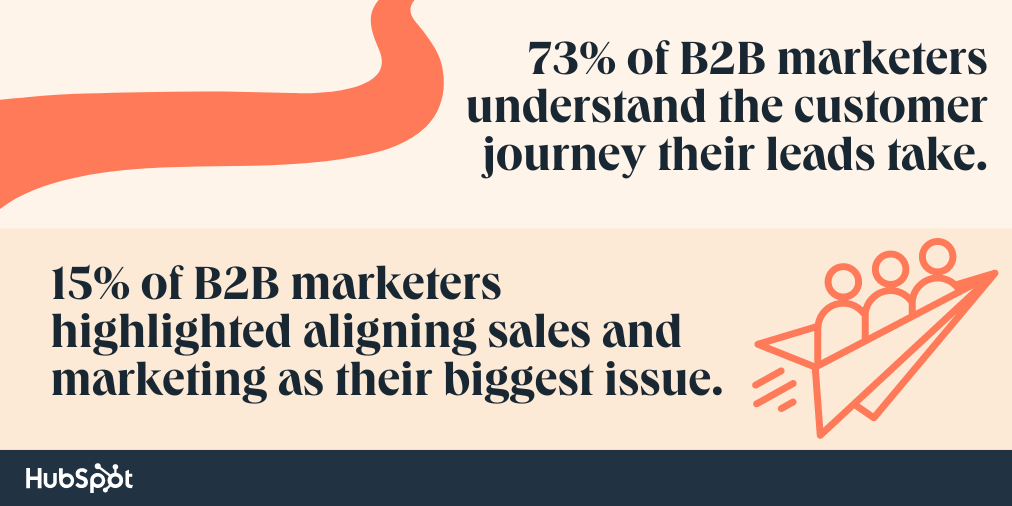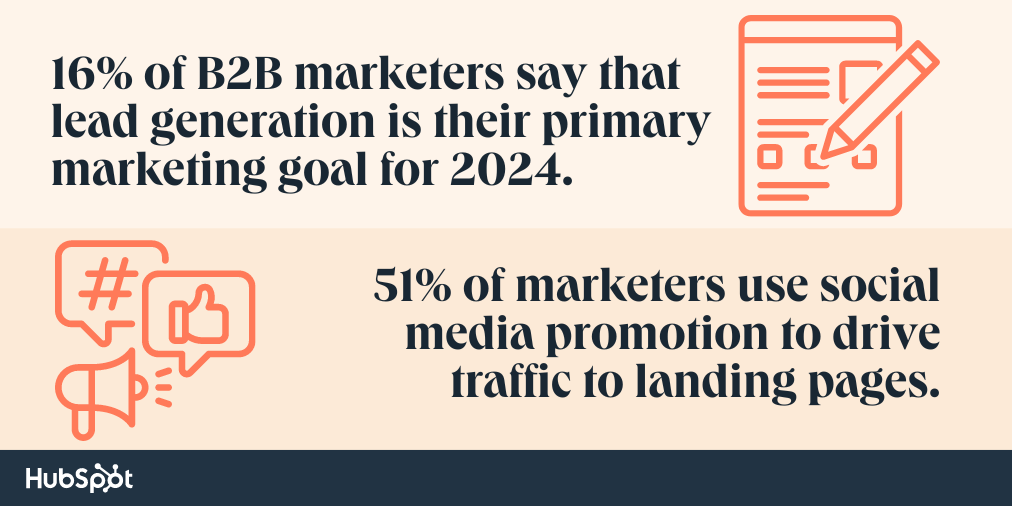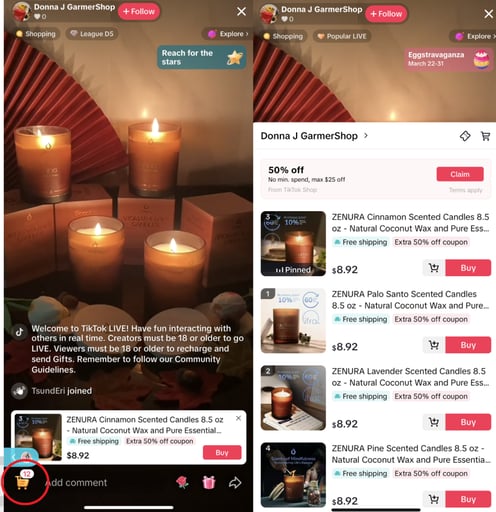Remember the story about Plato’s cave? Here’s a refresher. One group of people lives in a cave only sees shadows; the philosopher who escapes can see things for what they are.
That’s somewhat how it feels when making conclusions about B2B marketing without the right stats.
You simply have no ground to stand on, no lifeline to grab, before the naysayers and doubters sway your decision-making and alter the success of your strategies.
With data, you’re able to see the big picture. Buckle up, leave your preconceived notions about B2B marketing at the entrance, and let’s get into the nitty-gritty. All of the stats below come from HubSpot’s original research.
B2B Marketing Strategy Stats
- 66% of B2B leaders and 62% of B2C leaders say their companies have leveraged AI tools, while only 57% of sales leaders responded positively to the same question. (HubSpot’s State of AI Report)
- 74% of B2B leaders and 68% of sales leaders deem AI/automation tools important to their overall business strategy. (HubSpot’s State of AI Report)
- 69% of B2B leaders say they have the necessary data to reach their audience effectively, 19% are unsure, and 12% say that’s not the case. (HubSpot’s State of Marketing Report)
- A noticeably smaller 68% of sales leaders think they have all the data necessary for reaching target audiences in an effective way. (HubSpot’s State of Marketing Report)
- 68% of B2B marketers say they possess high-quality data on their target audience, while 32% disagree or are unsure. (HubSpot’s State of Marketing Report)
- 74% of them can turn that data into meaningful insights, while 26% can’t or can’t tell with certainty. (HubSpot’s State of Marketing Report)
- 73% of B2B marketers understand the customer journey their leads take, while 27% either don’t or are still on the fence. (HubSpot’s State of Marketing Report)
- Even though a whopping 76% of B2C marketers say their niche changed more in the past three than in the past 50 years. Only 68% of B2B marketers agree. (HubSpot’s State of Marketing Report)
- 15% of B2B marketers highlighted aligning sales and marketing (smarketing) as their biggest issue, with keeping up with trends, generating traffic and leads, and lack of high-quality data coming in at a close second at 14% each. (HubSpot’s State of Marketing Report)
- 27% of B2B marketers singled out planning ahead in case pivots are necessary, which is the biggest way that the industry has changed. That involves changing plans for major events like recessions, pandemics, and political turmoil. (HubSpot’s State of Marketing Report)

What This Shows
What’s immediately apparent from these strategy-related B2B marketing stats is that B2B leaders have to think ahead. That includes planning for changes in an uncertain market and adapting to new technology like AI.
However, what’s paramount for any AI-powered B2B marketing strategy to work is data.
Although it’s become the new gold, a whopping third of B2B marketers don’t have data that’s good enough, while a fourth has the data but doesn’t know how to turn it into something usable.
So, in 2024, data makes all the difference. That’s especially true when B2B marketing stats keep showcasing the changing nature of the industry. So, marketers should learn how to use that data quickly.
B2B Lead Generation Stats
- 16% of B2B marketers say that lead generation is the primary marketing goal for 2024. (HubSpot)
- Lead generation is considered the most important metric for measuring the effectiveness of content strategies, according to 29% of B2B marketers. (HubSpot)
- 44% of marketers most commonly try to generate leads with landing pages — followed by customers or direct purchases at 34%. (HubSpot)
- 51% of marketers use social media promotion to drive traffic to landing pages — followed by 44% who use email promotion, 36% who use SEO practices, and 33% who use paid advertising. (HubSpot)
- According to 39% of marketers, videos on landing pages positively impact conversion rates. (HubSpot)
- Lead generation is the most important metric for measuring the effectiveness of content marketing strategies, according to 29% of marketers. (HubSpot)
- AI saves about 2 hours and 16 minutes for manual tasks. (HubSpot’s State of AI Report)

What This Shows
Surprise, surprise, another year, another survey where the importance of lead generation is reinforced.
Despite the AI fanfare, the staples are still there — good, fleshed-out landing pages with the occasional video and sufficient social media promotion, of course.
B2B Marketing Team Stats
- 50% of all B2B marketers deem sharing data with other teams an easy affair.
- The goodwill works both ways, with 52% of marketers saying getting that same data is easy. (HubSpot’s State of Marketing Report)
- Even though 56% of marketers said their teams have become more aligned with sales, 31% stated the relationship hasn’t changed. (HubSpot’s State of Marketing Report)
- At the same time, the importance of alignment has changed according to 53% of marketers, while 33% consider the alignment to be status quo. More alarmingly, 14% state the importance of that alignment has further decreased in 2023. (HubSpot’s State of Marketing Report)
- Why is this alignment important? 29% of marketers said it benefits lead quality, while 26% each have selected customer experience and strategy execution as one of their biggest benefits of sales-marketing alignment. (HubSpot’s State of Marketing Report)
- If the machine isn’t well-oiled, calamity ensues. 39% say the biggest damage comes in the form of lost revenue, while 38% believe the poor impression it leaves is crucial. (HubSpot’s State of Marketing Report)
- But then again, it’s also the area of alignment that’s important. Sharing customer data and overall strategy led the way by being picked by 39% of marketers each, while content creation was the choice of 37% of them. (HubSpot’s State of Marketing Report)
- Despite all the benefits, 32% of surveyed marketers say that a lack of communication was their biggest obstacle on the road to team alignment. Different tools and the lack of alignment on goals are other culprits, according to 29% of marketers. (HubSpot’s State of Marketing Report)
What This Shows
Contrary to popular belief, Skynet hasn’t subjugated us all, and jobs haven’t been replaced by AI.
It’s the exact opposite, really, with interaction between teams becoming an even bigger factor in the successful implementation of automation-aided strategies. We have more time now, right?
Yes, but almost a third of B2B marketers have stated that their teams haven’t become more aligned with sales teams.
In an environment where production is ramping up, this might present itself as an issue that might manifest in lost revenue and a deteriorating brand image.
Once again, we circle back to the issue of sharing and giving data. Whether it’s due to the creation of data silos, a lack of communication, or simply incompatible software, the gap is still a wide one.
Fortunately, the influx of various AI solutions, as well as open-source LLMs, provides hope that marketing and sales teams will be able to coexist on a single platform, without a hitch in communication.
B2B Social Media Strategy Stats
- Facebook and Instagram seem to be the best social media channels in terms of ROI — 29% of B2B marketers saw the greatest returns there. YouTube comes in third place with 26%, while TikTok was the most profitable avenue for 24% of B2B marketers. (HubSpot’s State of Marketing Report)
- TikTok and Discord are the channels that will see the most increases in activity from marketing teams. 53% and 46% of B2B marketers plan to increase budgets for these platforms, with LinkedIn following closely at 45%. (HubSpot’s State of Marketing Report)
- 16% of B2B marketers plan to start leveraging YouTube for the first time in 2024 — slightly ahead of TikTok and Twitter/X at 15%. (HubSpot’s State of Marketing Report)
- LinkedIn is the hotspot of B2B marketing — 17% of B2B marketers plan to invest the most in this platform, followed by TikTok and Instagram at 13%. (HubSpot’s State of Marketing Report)
- 97% of B2B marketers consider generative AI tools either effective or somewhat effective. (HubSpot’s State of AI Report)
- However, this doesn’t mean that human oversight is unnecessary. When using AI to write copy, 52% of marketers make minor edits to the text — while 41% make significant changes, with an additional 7% changing it completely. (HubSpot’s State of AI Report)
- Surprisingly, a slight minority of companies work with influencers — with only 46% of polled marketers saying that their company worked with creators or influencers in 2023. (HubSpot’s State of Marketing Report)
- In terms of audience size, micro-influencers (with 10,000 to 100,000 followers) were the most utilized, with 61% of marketers collaborating with this category. (HubSpot’s State of Marketing Report)
- Micro-influencers were also the most successful category, with 48% of marketers being satisfied with the provided results. (HubSpot’s State of Marketing Report)
- 50% of all B2B marketers deem sharing data with other teams an easy affair.

What This Shows
Meta retains its dominant position as a social media channel for marketing. Although Facebook and Instagram drive the biggest returns, those markets are mature and saturated.
Newcomers in the space like Discord and TikTok are the new frontiers where businesses will vie for visibility.
The rise of TikTok is even more notable. The platform barely lags behind YouTube in terms of popularity. It will also receive plenty of new attention from marketers in the coming year.
To supplement this, it is also the platform that will derive the biggest investments from marketers after LinkedIn.
YouTube, TikTok, and Twitter/X surprisingly seem to be underutilized — with double digits of respondents saying that they will leverage these platforms for the first time this year.
Two more broad insights can be derived from the showcased data. Generative AI tools are broadly accepted as effective, although human oversight and editing are obviously still necessary.
In terms of influencer marketing, micro-influencers, the hot topic of yesteryear, seem to have paid off.
The smaller communities associated with them, such as meme pages, provide better results compared to online presences with larger reaches, like celebrities.
B2B SEO Stats
- Website and blog SEO is the second-most leveraged marketing strategy in the B2B space, with 32% of marketers reporting having used it. It is only slightly surpassed by physical events and tradeshows at 33%. (HubSpot’s State of Marketing Report)
- In tandem with this, updating SEO strategies to prepare for generative AI in search (like Google Search’s Generative experience) will cause 40% of B2B marketers to increase their budgets. (HubSpot’s State of AI Report)
- 50% of B2B marketers plan to increase SEO budgets in 2024. An additional 43% plan on investing the same amount as they did before. (HubSpot’s State of Marketing Report)
- With regard to content marketing, improving SEO performance is a big priority — 11% of B2B marketers singled it out as their biggest challenge. (HubSpot’s State of Marketing Report)
- 39% of B2B marketers consider sales the most important metric for measuring the success of content marketing strategies — 30% consider web traffic more important, and 20% consider conversion rate the most important metric. (HubSpot’s State of Marketing Report)
- 46% of polled marketers believe that the advent of generative AI will make SEO more effective. 39% think it won’t have much of an impact on SEO, while just 15% think it will have negative impacts on SEO. (HubSpot’s State of Marketing Report)
- Updating SEO strategies for Google’s algorithm changes is being undertaken by 22% of marketers, while updating strategies for generative AI is being leveraged by 21% of marketers. (HubSpot’s State of AI Report)
- This isn’t just being forward-thinking. For 6% of B2B marketers, keeping up with Google’s algorithm resulted in the biggest ROI in 2023. Updating SEO strategies for generative AI was the biggest driver of growth for 8% of marketers. (HubSpot’s State of AI Report)
- 12% of B2B marketers believe that AI-driven SEO optimization tools would help their business the most out of all AI tools. (HubSpot’s State of AI Report)
- Among bloggers and SEOs who use AI tools, automating time-consuming tasks such as meta tags, alt text, and link descriptions is the most common use case, along with analyzing website data. Both uses account for 42% of our polled sample. (HubSpot’s State of AI Report)
- 80% of polled bloggers and SEOs that already use tools agree that these tools will be able to do most SEO-related tasks completely independently by the end of the year. (HubSpot’s State of Marketing Report)
- There are also worries in the air — 78% of bloggers and SEOs who use automation tools are concerned that these instruments will eventually make SEO obsolete. (HubSpot’s State of Marketing Report)
- 69% of bloggers and SEOs who use AI agree that automation tools can optimize a website for SEO better than a human can. (HubSpot’s State of Marketing Report)
What This Shows
SEO is still one of the most dominant approaches to marketing in the B2B space, and updating SEO strategies to better fit search engine changes is a widespread priority.
In terms of AI use, the automation of time-consuming manual tasks and the analysis of large quantities of data are the most prevalent use cases.
Data shows that we’ll see budget increases industry-wide. Metrics that relate to SEO, like traffic and conversions, are notable priorities for B2B professionals.
Making the Most of Data
The B2B industry has undergone a massive change since the pandemic and the advent of AI. AI is seeing widespread adoption.
While it might be a bitter pill to swallow, this is the new normal, and the Luddites among us, like their namesakes, will unfortunately be left behind.
Adapting to these new realities isn’t a matter of optimization or peak performance anymore — it’s a question of being able to just stay in business. Marketers are in broad agreement here.
Learning how to effectively utilize these tools is do or die in terms of staying competitive as a business and retaining employment as a professional.
We’re on the cusp of a significant transformation, and keeping up is essential.
![]()

![Download Now: Free State of Marketing Report [Updated for 2024]](https://i4lead.com/wp-content/uploads/2024/04/db725f24-564c-483b-a28c-2d6ff9986516.png)

![Free Ebook: The Marketer's Guide to TikTok for Business [Download Now]](https://i4lead.com/wp-content/uploads/2024/04/2c7242e4-ad54-4f63-8627-a15aa6a2ea50-1.png)



 And I’m not the only millennial influenced.
And I’m not the only millennial influenced. 




















![New Data: Instagram Engagement Report [Free Download]](https://i4lead.com/wp-content/uploads/2024/04/9294dd33-9827-4b39-8fc2-b7fbece7fdb9.png)








![→ Click here to access 5 free cover letter templates [Free Download]](https://i4lead.com/wp-content/uploads/2024/04/3f347702-d7e9-4e59-9fe4-be4cd7bad191.png)












![Download Now: The 2023 State of Social Media Trends [Free Report]](https://i4lead.com/wp-content/uploads/2024/04/3dc1dfd9-2cb4-4498-8c57-19dbb5671820.png)

![Free Ebook: The Marketer's Guide to TikTok for Business [Download Now]](https://i4lead.com/wp-content/uploads/2024/04/2c7242e4-ad54-4f63-8627-a15aa6a2ea50.png)
